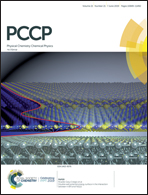How ions block the single-file water transport through a carbon nanotube
Abstract
Understanding the blockage of ions for water transport through nanochannels is crucial for the design of desalination nanofluidic devices. In this work, we systematically clarify how ions block the single-file water transport through a (6,6) carbon nanotube (CNT) by using molecular dynamics simulations. We consider various pressure differences and salt concentrations. With the increase of pressure difference, the water flux shows a linear growth that coincides with the Hagen–Poiseuille equation. Interestingly, the dependence of the CNT–ion interaction on the salt concentration results in a distinct ion blockage effect that ultimately leads to water flux bifurcation. The water translocation time shows a power law decay with pressure, depending on the salt concentration. Furthermore, with the increase of salt concentration, the water flux shows a linear decay with a larger slope for higher pressure, while the water translocation time shows an opposite behavior. Therefore, the ions can not only block the water entering but also slow down the water motion inside the CNT. Notably, the probability of cations and anions appearing at the CNT entrance is quite similar, suggesting a similar blockage effect; however, anions show deeper interactions with the CNT because of their larger size. We finally find a unique linear relation between the water flux and occupancy divided by the translocation time. Our results provide insightful information on the ion blockage effect for the single-file water transport, and are thus helpful for the design of novel filtration membranes.



 Please wait while we load your content...
Please wait while we load your content...